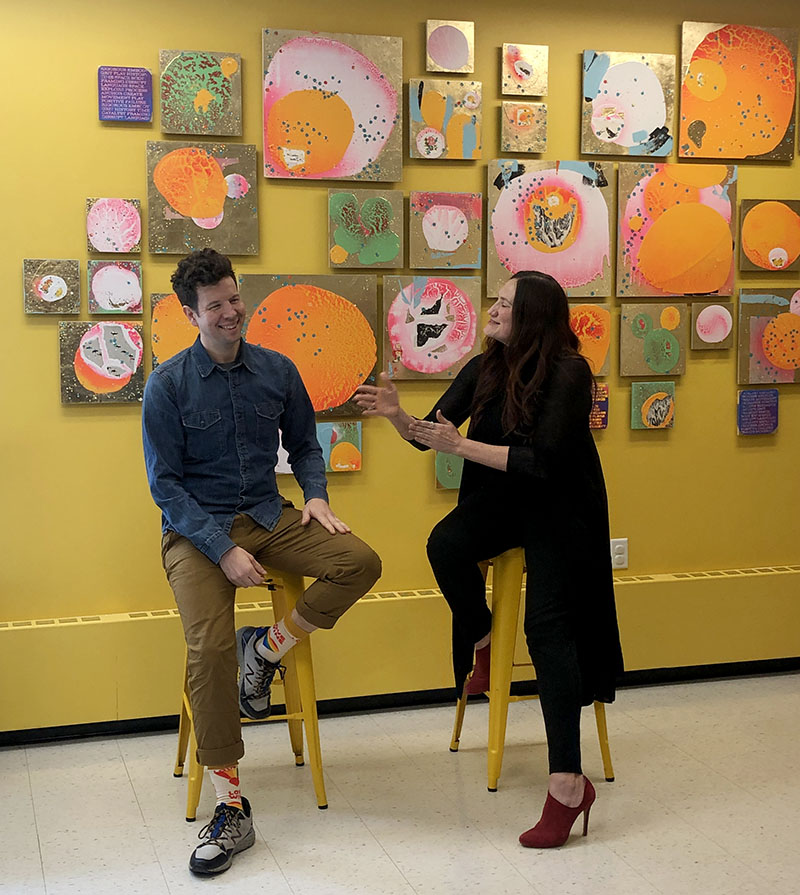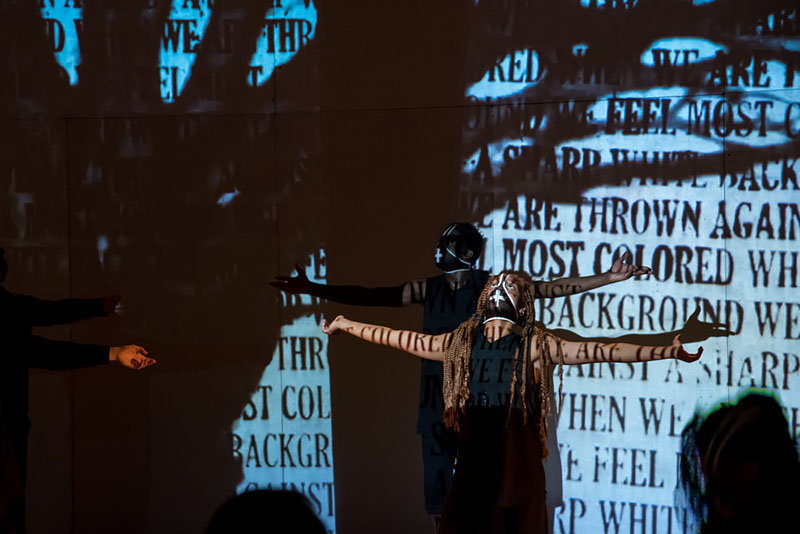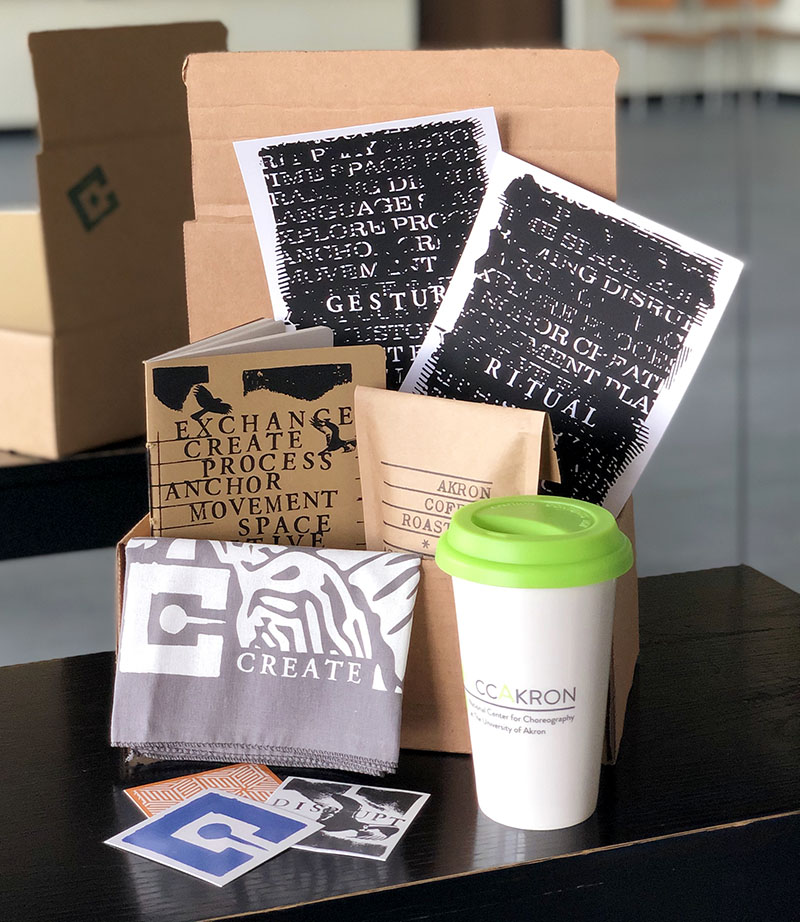Transcending Time, Place, and Space
An Interview with Christy Bolingbroke at NCCAkron
BY EMMALY WIEDERHOLT
Christy Bolingbroke is the Executive and Artistic Director at the National Center for Choreography at The University of Akron (NCCAkron) in Akron, Ohio. NCCAkron provides dance makers and their collaborators an array of research opportunities, working spaces, and resources. Here, Christy discusses how NCCAkron has moved toward alternatives to in-person residencies. She also shares how technology is reshaping audience interaction toward more online artist-created content.
This interview is part of a series looking at how dance organizations have responded to the tumultuous events of 2020.

Micah Kraus in dialogue with Christy Bolingbroke, Photo by Dale Dong Photography
~~
What was NCCAkron’s initial response to the pandemic back in March and April?
We had the Stephen Petronio Company on the ground. The University of Akron suspended face-to-face instruction, but because we had a group of less than 20 people, we could still use the space. We reached out to the Petronio Company and asked if they still wanted to come, and they said yes. New York had not shut down yet. Stephen said he felt like they were the last dance company on Earth. We added more cleaning products, and there were not a lot of people around. As Ohio started closing restaurants and bars, and things started getting progressively worse in New York, Stephen decided to end the residency early.
We had two more residencies planned that spring: Nicole Klaymoon for a tech residency and Taja Will for a creative residency. We worked with both up until a week or two before they would have arrived to see where they were in this new normal. Ultimately, they both decided to postpone. We were able to secure NEA CARES Act funding, which was only available for existing programs or salaried positions. We still wanted to support those artists. They have until June 2022 to reschedule with us and use the funding, which is amazing.
Those were the immediate things to take care of. Internally, I had expanded my team three months prior to a group of contractors. I reached out to them and let them know we would work remotely if they still wanted to do the work. We pivoted into weekly meetings. It was the height of grant writing season; there were still deadlines, which felt crazy but gave us purpose.
After observing my colleagues in other institutions, I appreciated how NCCAkron didn’t have to repeatedly suffer the trauma of cancellation. When I think of larger venues that do 40-50 weeks a year of programming and rentals, they were cancelling six weeks out, and then another six weeks out. It wasn’t until June and July that wholesale postponements and cancellations happened. I watched colleagues who were living in that trauma and mourning what would have been. NCCAKron certainly had those moments, but we inherently have a higher threshold to commit to uncertainty because we’re all about process. We don’t have public facing engagements, so we didn’t also have to work to support not only the artists but also hundreds of ticket buyers.
How did NCCAkron shift (or did it shift) in response to the George Floyd protests this past summer?
This coming year is NCCAkron’s 5th anniversary. In mid-May, we had a virtual board retreat. We had been working with Jennifer Edwards and Shannon Reynolds at a consulting company called Better_ out of Philadelphia. In December 2019, we started our strategic planning process. A big part of our vision for the next five years is: How do we stay artist-centered and how are we a bridge between 20th century dance practices and 21st century dance ecology?
Then George Floyd’s murder happened. As a team, we grappled with what to do. Rather than knee jerk into a statement, we came together for another virtual meeting and reflected on what we are already doing, what we could do better, and what it means to be antiracist. It’s not a moment of defensiveness but a moment to acknowledge what we’ve done and where we could do more. We did put out a brief statement on Facebook because we didn’t want to be complicit with silence, but we really saw it as an opportunity to use our strategic plan. The strategic plan is now finalized, and we’ve continued to actively seek out allyship and antiracist opportunities and training to practice this work. Now we’re starting to also realize we don’t operate in a vacuum. Being a nonprofit organization on a college campus, how can we lead with our colleagues in the field? Dance has something specific to say about being antiracist because it’s all about the politics of the body.
What are some ways NCCAkron is currently responding to the needs of the dance community?
COVID has erased some of the constrictions around dedicated time and space. We’re not limited anymore to bringing artists to town and seeing how much they can do in 10 days, with a day and a half of travel each way. Or even the invitation to think about space differently: If you’re not in a studio, are you doing site specific work? What about mental space versus physical space?
There are a couple programs we were doing anyway, but their relevance became greater. In February 2020, we were named series editor with the University of Akron Press. Our first book has been approved and will be published in July 2021. It’s by Hope Mohr about shifting cultural power and a reflection on the 10-year anniversary of the Bridge Project. It personally gave me a lot of solace in making meaning out of the senseless events in the world and especially George Floyd’s murder. We’re also commissioning essays. We reached out to artists who then named writers to write an essay on their work. We collected those essays and will be submitting that manuscript for approval this winter.
We had a couple of artists who were supposed to come this past summer, fall, or this coming spring. I proposed three different budgets to my board for approval. One had some travel possible throughout the year, determined by which state the artist was coming from and the time of year. The second had no travel at all in the fall, but maybe in the spring. The third had no travel at all, which doesn’t mean we’re not supporting artists. Travel expenses might go down in different scenarios, but our artist fees do not. For example, we were supposed to have a Dancing Lab with Sean Dorsey Dance in August 2020. Sean elected to use part of the budgeted funds as a satellite residency this year.
Everybody is talking about doing things virtual or remotely, but we really like the idea of satellite because it geo-locates in relation to Akron, Ohio. We liked the idea that we could support artists wherever they are, and also add to the work we do. Sean’s team really got into that and there was a sense of increased mindfulness and nourishment – there in San Francisco and for us here in Akron.
We also did a residency with Charles O. Anderson, who was translating a piece of his, (Re)current Unrest, into an edited livestream. The piece was originally supposed to have local performers, so how could he do that in the virtual space? We supported him with a satellite residency to experiment with virtual dance workshops.

Charles O. Anderson’s (Re)current Unrest, Photo by Jon Haas
We also explored that idea of transcending time, place, and space by experimenting with something called Residency-in-a-Box. We couldn’t bring people to Akron; how could we send a little bit of Akron to people to use creatively in whatever space they are in? Before the pandemic, we had worked with a local screen print artist, Micah Kraus, to riff off our logo for an art piece in 28 parts in our office. It’s called Migration Patterns. That work was then translated into a handmade journal, stickers, and a bandana. The kit also included a coffee tumbler and local beans from Akron Coffee Roasters. We had never sold anything before, but this was a way we could get some of NCCAkron out in the world. It also responded to the social justice movement, as all proceeds went to one of five organizations doing equity work in dance: Native Arts & Culture Foundation, The International Association of Blacks in Dance, Exchange House Akron, Creating New Futures Coalition, and Alternate Roots.
How do you think 2020 is going to impact NCCAkron in the long term?
We’re in a very fortunate position. What’s happened this year has, if anything, heightened what we do. By that I mean we were interested before COVID in dance writing and how people can tell their stories, and now more people are telling their own stories by developing podcasts or livestreaming weekly series. There’s this 20-year-old idea that the internet is possibly an equal playing field. Artists no longer have to wait for a news outlet to tell their story. That’s something we were already interested in developing.
How do you think 2020 is going to impact the dance field in the long term?
It comes back to transcending time, place, and space. What used to be the norm has been upended. One of the things I hold for myself and colleagues is to not revert when things get back to normal. Let’s reach for better. How do we want to move forward? What do we want to let go of? What new things do we want to discover?
I’m excited about more dance films getting made to varying degrees of success. Those newer to dance film may have 20-30 years under their belt as a choreographer but are making film for the first time. It’s like they are a fish out of water. For those who have been focused on getting into venues, now another option is to be a kick-ass dance filmmaker.
The other thing that’s coming up is blurring product versus community engagement. It used to be there’d be a performance and then a talk back afterward or a masterclass the next day. Some artists before COVID were starting to say it’s just as important to engage with community members as it is to perform a finished work. I think about Emily Johnson as an artist interested early on in centering activities that were previously ancillary. Now more artists and presenters are talking about creating meaningful interactions. I’m hopeful we won’t lose some of these new tools.
Even before COVID, social media was changing how dance was perceived. Institutions need to support dancers by finding new ways of working. For a professional dance company or venue, the typical engagement would be a show that is marketed to single ticket buyers, which eventually became season ticket buyers, donors, or board members. But now, the first point of interaction is no longer coming to a show. That first point of interaction is now online. Organizations need to rethink that pipeline of engagement. If the first point of engagement is livestreamed videos, what are institutions doing to get to know those people so it’s no longer a passive interaction? How can that lead to monetization?
I believe it’s incumbent on dance institutions that serve artists, not dance artists themselves, to help monetize content. Lots of dance artists and organizations experimented with free content this spring. Then it became a donation basis. And now people are starting to set up subscriptions. This is something I’m keen to check in on a year from now. No one knows what to expect in terms of financial goals.
I’m excited for those who have found ways to make it work. For example, there’s something called Dance Church out of Seattle. A program by Kate Wallich/The YC, it’s advertised as the dance party you wish you’d been at the night before. They were doing it before COVID with a leader on a mic and a live DJ. Within a week of the shutdowns it was online. It is donation based with an estimated $10 per person. I’ve heard most people do donate, and every time I’ve logged on, thousands are participating. That model wouldn’t work for everyone, but Dance Church is an example that does translate to an online space.
~~
To learn more, visit www.nccakron.org.

NCCAkron’s Residency-in-a-Box, Photo by Christi Welter
